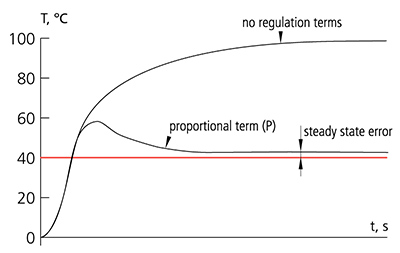Industrial PID controllers
PID controller is a very widely used type of process controllers in industrial automation. The reason is its high accuracy and efficiency.
Today, akYtec offers PID controllers for three special purposes:
- TRM210 for general applications
- TRM212 for valves with analog or 3-step control
- TRM500 for industrial ovens
All three are equipped with two 4-digit LED displays for displaying process value, set point and configuration parameters. Device enclosures are of IP54 (except wall mount version, IP44) protection class on the front (IP20 on the rear) and can be operated in the temperature range from +1 to +55°C.
The TRM210 is a PID process controller for general applications which, besides the TC and RTC temperature signals, also support analog input signals of 4-20 mA and 0-1 V. These stand-alone devices feature two optional outputs of different types: 4-20 mA, 0-10 V, Relay, NPN, TRIAC, SSR. Filtering of the input signal, signal correction, square root function and many other functions make this PID controller particularly flexible in application for different types of tasks. This controller can be easily connected to an industrial Modbus network due to the RS485 interface (Slave only).
The TRM212 is a weather-compensated PID controller for 3-step control valves. Therefore, besides all functionality (except on-off control) of the TRM210, the TRM212 support many additional functions, which mostly refers to the control of analog or 3-step control valves.
The TRM500 temperature controller for industrial ovens is a universal PID controller for panel mounting which supports a wide range of TC and RTC. This device also features a digital input, which can be used for three purposes: set point switching, on-off control, switching to the manual mode of operation. The TRM500 is equipped with two relay outputs (5A, 3A and 20 A supported), an SSR output (0/5V, 25-40 mA).
PID CONTROL IN GENERAL
PID controllers are often referred to as three-term controllers. This is because they utilize PID algorithm of control, which is based on three terms:
To say it simply, the proportional component is responsible for coping with the present error, the integral component takes into the account all errors in the past, and the derivative component predicts process changes in the future. The combination of these three components makes the strategy of the process control.
PID CONTROL APPLICATION
Typical industrial application examples of PID controllers can be the next:
Temperature control in a batch reactor. As a batch reactor is a closed system the probability of noise is very low here. In addition, the heat in such systems is usually added and not subtracted. Also, the dynamics of such process are non-linear and slow. Such process conditions make for an ideal application of PID control.
Control of the temperature in a furnace. A furnace is usually stuffed with a raw material of a large mass, that’s why its temperature rises very slowly even with a high set point. Therefore, this process is quite inertial. Due to these conditions, the process variable is relatively steady, what allows the derivative component effectively correct the error without excessive switches to either the controller output or the final control element.
Control of the pH neutralization. The pH neutralization is a very dynamic and non-linear process that’s why it’s hard to control. Nevertheless, PID control algorithms fit here perfectly. As the amount of the acid or the caustic usually added to the process is small as to the volume of liquid, the dynamic of pH tends to be slow. Thus, the derivative component improves the control due to exception any overworking the final control element.
In spite of about 90% of closed-loop control systems involves a PID controller, about 30% of these controllers might be tuned not proper enough, and as a result, it leads to significant loss in their efficiency. Thus, as we can see, the correct setting of the gain constants (especially the derivative gain) is a really great challenge to the proper operation of PID controllers.
To solve this matter all akYtec PID controllers support auto tuning function. When using this function, the PID controller operates in the on-off control mode for a little while. Later on, when the P, I and D constants are calculated and saved, the device switches its operation to the PID mode. By applying the auto tuning function, the most proper PID gains are determined in accordance with the process behavior.
Very often, there is no need to involve all three factors of the three-term controller. For this purpose, PID controllers from akYtec support manual tuning. This way, if any of three coefficients is set to 0, then the appropriate term isn’t included in the control algorithm. Combinations of PI and PD controls are very often used in practical applications.
There are no products matching the selection.



